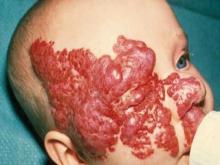NEW ORLEANS - A blood pressure medication that has been in use for decades also could be an effective treatment for hemangiomas, the most common benign growths in children.
"People talk about products of the year, people of the year, and most handsome and most beautiful, but this is the drug of the year for [those of us] who are taking care of children," said Dr. Sheila Fallon Friedlander, professor of clinical pediatrics and medicine at the University of California, San Diego, and section chief of pediatric dermatology at Rady Children's Hospital in San Diego.
The beta-blocker is propranolol, which Dr. Friedlander called a "not-so-new kid on the block." For nearly 5 decades propranolol has been used to treat high blood pressure in adults and children. But over the past 2 years evidence has emerged showing that propranolol can be an effective treatment for hemangiomas.
The drug's effect on the infantile growths was a serendipitous discovery by observant French physicians who treated two infants for hemangiomas with corticosteroids and administered propranolol for other medical conditions (N. Engl. J. Med. 2008;358:2649-51). Within 1 day of administration of propranolol, the hemangioma changed in color and softened. The improvements continued even after corticosteroids were tapered and discontinued, and no regrowth was noted. Since then, other studies, including a follow-up by the French researchers, have shown that propranolol can rapidly shorten the natural course of hemangiomas.
The treatment comes with a caution, said Dr. Friedlander. Despite positive results and a good safety profile, there are still many unknowns, such as the proper dosage and length of treatment. The mechanism of the drug is not known.
Dr. Friedlander is participating in a large multinational study investigating propranolol. The patients are monitored closely during the study period, because improper use of the drug could lead to serious conditions such as low blood sugar, changes of heart beat rhythm, changes in blood pressure, and wheezing, she said.
Dermatologists should consider using the drug when the hemangioma is functionally deforming, causing pain, or creating problems with vision or airway. But Dr. Friedlander suggested referral to a dermatologist who has experience using the drug. "We have some great new treatments with great effects, but they have to be used very carefully."
Roughly 10% of children have hemangiomas, many of which are benign and disappear within a few months. But some turn into very serious lesions, leading to blindness, obstruction of the airway, and painful genital ulcers.
A study of more than 1,000 children (Pediatrics 2006;118:882-7) showed that 24% of children with hemangiomas developed complications, and 38% needed treatment.
Steroids, laser therapy, and surgery are among the most commonly used treatments. The topical beta-blocker ointment timolol could be an alternative to propranolol, and it has shown some promise, according to Dr. Friedlander, but the results so far haven't been as impressive as those achieved with propranolol.
Dr. Friedlander is a clinical investigator for a hemangioma study sponsored by Pierre Fabre.


